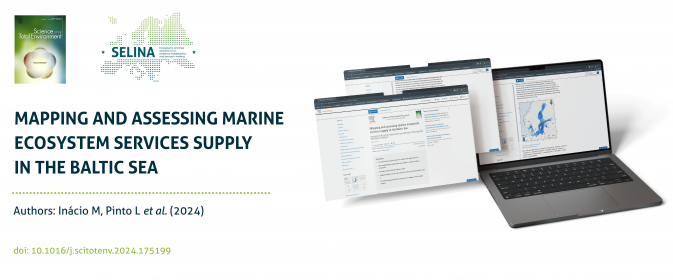Mapping and assessing marine ecosystem services in the Baltic Sea: Insights from SELINA's latest study
The recently published SELINA article “Mapping and assessing marine ecosystem services supply in the Baltic Sea” introduces three methodological frameworks that were applied to quantitatively map and assess marine ecosystem services (ES) supply across the Baltic Sea in a spatio-temporal perspective. Published in the multidisciplinary, peer-reviewed journal Science of the Total Environment, the study reveals that ecosystem services are responsive to changes in socio-ecological systems.
Coastal and marine ecosystems supply multiple Ecosystem Services (ES). Nevertheless, these ecosystems are among the most impacted by human activities, harming the ES sustainable supply. Since ES are a spatial phenomenon, mapping can contribute to understand ES supply. For this, the authors of the article use quantitative spatio-temporal frameworks to map and assess the supply of one provisioning (food from fisheries) and two regulating ES (nursery habitats and nutrient regulation), considering two periods: Baltic Sea Holistic Assessment (HOLAS) 2 (2011–2016) and 3 (2016–2021). The ES supply was assessed following a process-based modelling approach, using bio-physical indicators as proxies. The three ES models were applied and validated, showing moderate results. For fisheries and nursery ES the results showed a significantly higher supply in HOLAS 3 than in 2, and for nutrient ES the opposite. This indicates that the assessed ES changed due to environmental activities.
The article concludes that quantitative mapping and assessment of coastal and marine ES is essential to unveil their importance in supporting human wellbeing. The authors have performed an essential step towards increasing the reliability of results: validation. All results showed a clustered pattern and the ES spatial distribution. Significant correlations were found between fisheries ES, nursery ES, and nutrient ES. No significant correlations were identified between nursery ES and nutrient ES. The methodological approach applied was based on freely available datasets (e.g., Copernicus Marine Service), facilitating the framework transference to other marine ecosystems (e.g., the Mediterranean Sea). Similar indicators are related to fisheries (e.g., fishing intensity) and biogeochemical processes (e.g., NH4). Overall, the results obtained are essential to support coastal and marine management and planning in the Baltic Sea as well as international environmental policies and directives.
Read full paper here.
